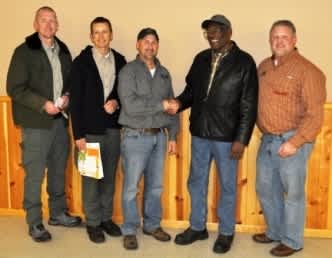Quail Forever in Minnesota Completes First-Ever Land Acquisition Project to Benefit Bobwhites
Quail Forever 10.20.14

Quail Forever (QF) and the Minnesota Department of Natural Resources (DNR) recently dedicated a 76-acre addition to Richard J. Dorer Memorial Hardwood State Forest. Dedicated in the memory of local conservationist Leo Whalen, the purchase marks the first-ever land acquisition project by Quail Forever in Minnesota since the organization was established in 2005.
Utilizing a Conservation Partners Legacy grant from Minnesota’s Outdoor Heritage Fund, Quail Forever and contributing partners have permanently protected a 70-acre addition on the east side of, and directly adjacent to, the Richard J. Dorer Memorial Hardwood State Forest. Creating wildlife habitat and permanently protecting Winnebago Creek, one of several southeast Minnesota trout streams in the area, the new addition will provide additional hunting and recreational opportunities to Minnesota residents.
“Through this project, our father’s legacy for protecting natural resources will be a permanent fixture in southeastern Minnesota,” expressed Paul Whalen, son of the late Leo Whalen who passed away in 2011. “Our family homesteaded this property almost 120 years to the day, and we are extremely proud to honor the memory of our father with such a great tribute to natural resources in this corner of the state.”
Leo Whalen spent his entire life on the family’s southeastern Minnesota farm and had a great affinity for the state’s natural resources. In the late-1980’s, Whalen was very instrumental in the trapping and transplant of wild turkey populations that have now flourished throughout many regions of Minnesota. Defined by his family as a conservationist first and a farmhand second, Whalen lived a life enriched by nature and enjoyed immersing himself in the outdoors. Whalen is survived by his family of five children including three sons and two daughters.
“This property is a strategic addition for increasing the bobwhite quail population that has been seen and heard in the immediate area,” said Thurman Tucker, area volunteer coordinator for the Quail Forever chapters in Minnesota. “Our Southeast Minnesota Chapter of Quail Forever is looking forward to working with the DNR in their efforts to improve the habitat on the Whalen family farmstead for the public to enjoy.”
Working in conjunction with the Minnesota DNR, the Metro Area and Southeast Minnesota Chapters of Quail Forever will be providing active management for the newest land acquisition in Minnesota. Quail friendly conservation practices will be established on the parcel, along with a forest management plan to provide future structure and specific habitat needs for bobwhite quail.
Directions to the new addition: From La Crescent, Minn., head south on Hwy 26 to the city of New Albin, Iowa, and then head west on CR-5 for about 1.25 miles and the property is on the right (east) side of the road, located on the Minnesota/Iowa border.
Quail Forever in Minnesota
Minnesota’s two chapters of Quail Forever account for more than 200 members statewide. Those chapters have spent more than $74,000 to complete more than 110 acres of habitat conservation projects since the first Quail Forever chapter was formed in Minnesota in 2005. For more information about Quail Forever in Minnesota, or to start a Quail Forever chapter, contact Chad Bloom at (320) 292-4771 / email.
Contact
Jared Wiklund (651) 209-4953

